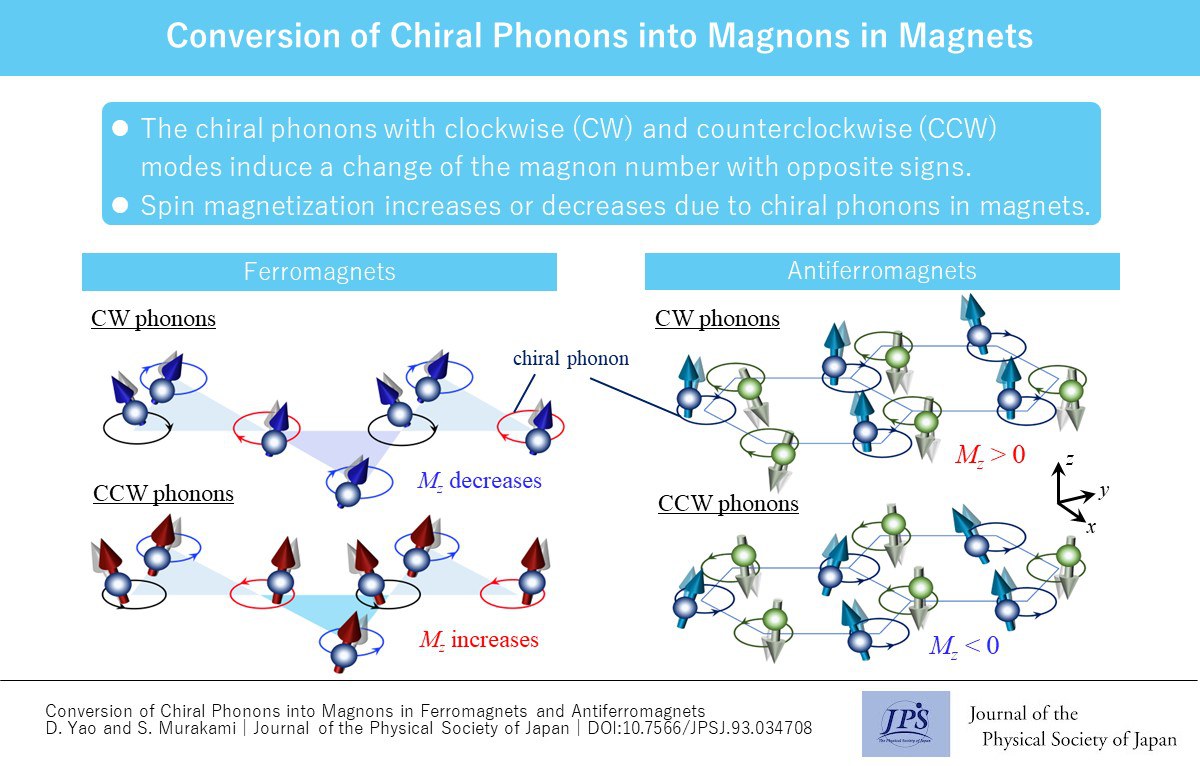Conversion of Chiral Phonons into Magnons in Magnets
© The Physical Society of Japan
This article is on
Conversion of Chiral Phonons into Magnons in Ferromagnets and Antiferromagnets
(JPSJ Editors' Choice)
J. Phys. Soc. Jpn. 93, 034708 (2024).
A new phenomenon involving the conversion of chiral phonons into magnons is theoretically predicted. The effective magnetic field induced by chiral phonons causes a change in the spin magnetization of magnets.

Spin-rotation coupling, which refers to the coupling between mechanical rotations and electron spins, leads to various phenomena, such as the Einstein-de Haas effect and the Barnett effect, in which the mechanical rotation of a crystal acts on the electron spins as an effective magnetic field. Recently, surface acoustic waves and chiral phonons involving the rotational motion of atoms have attracted considerable attention in spintronics. Surface acoustic waves refer to classical surface waves in continuous elastic media, whereas chiral phonons represent the microscopic local rotation of atoms with a phonon angular momentum.
Previous studies have indicated a phenomenon involving the conversion of phonon angular momentum into electron spins and charges in nonmagnetic materials and shown that chiral phonons behave as an effective magnetic field. Chiral phonons accompanying atomic rotations modulate electron hopping and spin-orbital coupling because the distance between atoms periodically changes with time. In the case of magnets, spin-spin interactions, such as exchange interactions and Dzyaloshinskii-Moriya interaction, always exist. These spin-spin interactions govern the collective propagation of precessions of electron spins, which are known as magnons. However, the interplay between atomic rotation and magnons in magnets is not fully understood.
In this study, we investigate a new conversion of chiral phonons into magnons in both ferromagnets and antiferromagnets and show that chiral phonons modulate spin-spin interactions. Because the masses of atoms are much larger than those of electrons, the behavior of magnon dynamics in an adiabatic response to atomic rotations leads to a geometric effect. We demonstrate that this effect requires breaking the spin-rotation symmetry. Consequently, the geometric effect due to chiral phonons results in a nontrivial change in magnon excitations. Specifically, chiral phonons with clockwise and counterclockwise rotational modes induce a change in magnon numbers with opposite signs, which corresponds to increasing and decreasing spin magnetization due to the chiral nature of atomic rotations.
The proposed effect is universal for a wide range of magnets. Measurement in an antiferromagnet is easier than in a ferromagnet because the net spin magnetization becomes nonzero owing to the geometric effect induced by chiral phonons. Our theory can generally be applied to real materials and is expected to be experimentally realized in some candidate materials, such as antiferromagnets XPS3 (X =Fe, Mn, and Ni), with a strong magnetic anisotropy.
(Written by D. Yao and S. Murakami)
Conversion of Chiral Phonons into Magnons in Ferromagnets and Antiferromagnets
(JPSJ Editors' Choice)
J. Phys. Soc. Jpn. 93, 034708 (2024).
Share this topic
Fields
Related Articles
-
Antiferromagnetism Induces Dissipationless Transverse Conductivity
Electronic transport in condensed matter
Magnetic properties in condensed matter
Electronic structure and electrical properties of surfaces and nanostructures
2024-7-24
An investigation using high-quality NbMnP crystals demonstrates that the anomalous Hall conductivity arising from antiferromagnetism is dissipationless, as expected from the intrinsic mechanism.
-
Exploring Electronic States in BEDT-TTF Organic Superconductors
Superconductivity
Electronic transport in condensed matter
Magnetic properties in condensed matter
2024-4-24
This review, published in the Journal of the Physical Society of Japan, provides a comprehensive summary of the electronic states observed in BEDT-TTF type organic superconductors, including metal-insulator transitions, Mottness transitions, non-Fermi liquids, quantum spin liquids, and Bose-Einstein condensation.
-
Variety of Mechanically Induced Spin Currents in Rashba Systems
Electronic transport in condensed matter
Magnetic properties in condensed matter
Structure and mechanical and thermal properties in condensed matter
2024-3-22
Various types of spin currents, including unconventional types, are generated in Rashba spin-orbit coupled systems by dynamic lattice distortions associated with, for example, surface acoustic waves.
-
What Determines the Sign of Spin Current? ~ Theoretical Study of Spin Seebeck Effect in Antiferromagnetic Insulators
Electronic transport in condensed matter
2024-3-18
We developed a microscopic theory for the spin Seebeck effect in antiferromagnets, that explains the sign reversal of the spin current at the spin-flop transition point and describes the sorts of dominant carriers.
-
Chiral Anomalies in Organic Dirac Semimetals
Electronic transport in condensed matter
2024-2-5
A three-dimensional massless Dirac fermion system exhibiting broken chiral symmetry was successfully realized in organic conductor α-(BEDT-TTF)2I3 under high pressures. Our study detected the chiral anomaly-induced negative magnetoresistance and planar Hall effects and opened new avenues for further advancements in the field.
